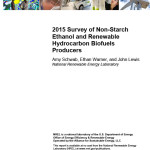2013 looks to be a strong year for biofuels
Many energy programs are poised to bolster assistance to advanced biofuels in 2013. That coupled with the near-completion (or completed) status of many commercial projects make the coming year look to be a crucial stepping stone in the plight of clean fuels.
At the end of 2012, several companies announced completed construction of commercial or large demonstration facilities.
KiOR began commercial production of renewable oil in Mississippi
INEOs Bio’s Florida facility began producing renewable power in its run up to renewable fuel
ZeaChem completed construction of its cellulosic ethanol facility in Oregon
Sapphire completed their algae facilities in New Mexico
Also in New Mexico, Joule Unlimited commissioned its first demonstration facility
With some other companies like DuPont breaking ground on new large-scale facilities, and the expected completion of several other projects, like POET’s Liberty facility (both Iowa based), commercial production seems to be moving from “five years away” to “already.”
The policies and programs that support these projects will have a telling year ahead. On Jan 1, the “fiscal cliff” legislation, the American Taxpayer Relief Act, restored the $1/gal tax credit for biodiesel and renewable diesel production. Importantly, this legislation also expanded the definition of cellulosic under the tax credit to include algal fuels.
This year renewable fuel proponents will fiercely defend the federal Renewable Fuel Standard as the driving force behind new commercial fuel projects. Even enhancements to the program are summarily dismissed for now, as the biofuel community does not want to open up this critical fuel policy.
We can also expect a decision on the Low Carbon Fuel Standard litigation, in which a federal appeal court will decide whether the LCFS violates the dormant U.S. Commerce Clause. The impact of this decision will impact regulatory decisions not only in California, but also in other states that are considering adopting similar programs like Oregon, Washington, and the Northeast/Mid-Atlantic region.
Of course, many policy and investment conversations must involve the cost of these fuels, and leave policymakers wondering at what point advanced biofuels can compete with petroleum counterparts. Many companies target $100/barrel petroleum prices as the point at which their product becomes competitive. Biofuels Digest recently ran an assessment of cost components from publicly available data, which finds that capital expenses are on track to meet this $100/barrel target, assuming feedstock prices remain around $50/bushel.
Plenty is being done in the realm of affordable feedstocks, from USDA-funded programs to companies like Proterro looking to produce affordable sugars. But that is a topic for another day.
After re-upping its commitment to advanced biofuels in late 2012, the Dept of Defense’s 2013 budget includes funding for biofuel projects that will be matched by the Dept of Energy and USDA. The military’s interest in advanced biofuels as a domestic energy source is a national security priority, which will provide a crucial market demand signal for the industry. For those critical of government assistance, take note that funding from government sources typically results in triple amounts of capital from the private sector.
In 2013 I’m also expecting to see continued biofuel market consolidation – plenty of mergers and acquisitions, a few failed projects, and a few big successes. By the end of what looks to be a banner year, we’ll know which projects have been experimental, and which projects are truly the harbingers of a new clean fuel future.
Filed in: Blog • Mary Solecki












